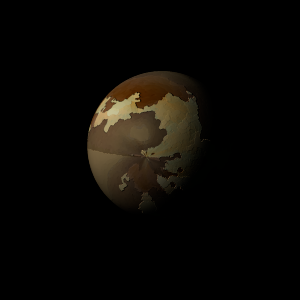| Fictional info (?) |
|---|
| Suggested name | Shozata Nobe |
| Planet type | Small gas planet |
| It is the coldest planetary atmosphere in its solar system, with a minimum temperature of 85°K (-188°C), and has a complex, layered cloud structure with hydrogen chloride thought to make up the lowest clouds, and carbon monoxide the uppermost layer of clouds.
. It may have had hydrogen oceans in the past, but these would have vaporized as the temperature rose due to a runaway greenhouse effect. The hydrogen has probably photodissociated, and the free carbon monoxide has been swept into interplanetary space by the solar wind because of the lack of a sulfur dioxide layer. |
| Atmosphere | Carbon monoxide | 58% |
| Hydrogen chloride | 33% |
| Hydrogen | 4.9% |
| Sulfur dioxide | 3.1% |
| Ethane | 0.00021% |
| Atmospheric pressure | 0.005 bar |
 |
| Moon | Komyoha Ipya | Large round ice moon |
| Sachu | Medium-sized potato shaped crater-filled asteroid |
| Gyamo Nyukyo | Medium-sized slightly egg-shaped crater-filled comet |
| Ryofuso-jipu | Medium-sized potato shaped gaseous moon |
| Nasu Myuga Tore | Medium-sized almost round rocky moon |
| Ngazo Pejo Pya | Large round rocky asteroid |
| Bihya | Medium-sized slightly egg-shaped crater-filled moon |
| Zaryushu-mo | Large slightly egg-shaped ice planetoid |
| Moisabo'ro | Medium-sized irregular crater-filled moon |
| Regyo-hyugyu | Very small irregular gaseous planetoid |
| Nyoiki Ga | Very small irregular oceanic comet |
| Bunyosha Nu | Very small round crater-filled asteroid |
| Kene Wopa | Huge potato shaped crater-filled moon |
| Itobyo Merahya | Huge almost round ice comet |
| Chufu Shocho Enyo | Small irregular oceanic moon |
| Pemyobya'ryazo | Medium-sized irregular oceanic asteroid |
| Ryuu | Medium-sized round rocky moon |
| Nuyomya-zehyo | Huge round rocky moon |
| Kozameno | Very small potato shaped rocky planetoid |
| Wokawayo Jinyu | Small round crater-filled asteroid |
| Bamupya Togao | Medium-sized round ice comet |
| Tomobya | Large irregular rocky moon |
| Google search for Shozata nobe |